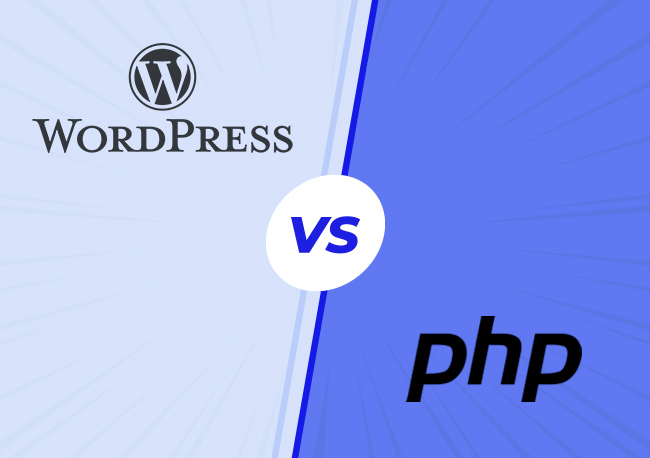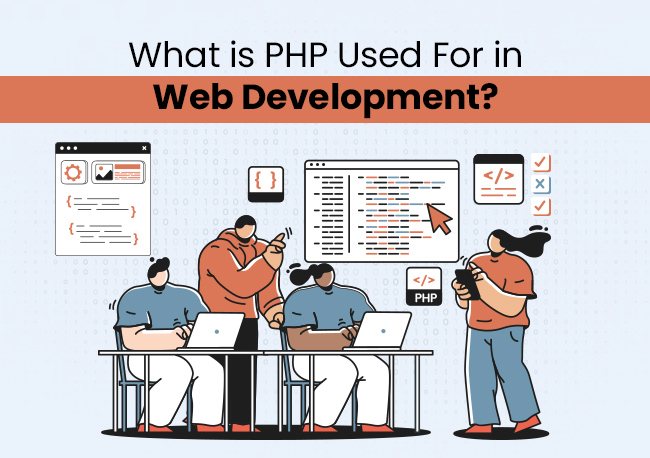| Getting your Trinity Audio player ready... |
Imagine walking into a beautifully designed coffee shop. The cozy ambiance, elegant furniture, and appealing decor immediately catch your eye. This is the frontend – what you see and experience as a customer. However, the seamless experience wouldn’t be possible without the backend: the unseen processes in the kitchen, the efficient supply chain, and the well-organized staff schedules.
In the world of web development, the distinction between frontend and backend development is much like this coffee shop analogy. The frontend is the visual, interactive part of a website or application, while the backend involves the server, database, and application logic that power the frontend.
To put this into perspective, consider the popular social media platform, Facebook. According to recent data, Facebook’s front-end development involves over 60 million lines of code to ensure a smooth user experience. Meanwhile, its backend infrastructure processes over 4 petabytes of data daily, managing everything from user profiles to real-time notifications.
Understanding the difference between frontend and backend development is crucial for anyone involved in creating digital experiences. In this blog, we’ll explore these roles in detail, highlighting their unique functions and how they work together to build the seamless web applications we use every day.
Importance of Understanding Frontend and Backend Development
Understanding both frontend and backend development is critical for overall web development skills. The front end controls the user interface and experience, whereas the back end controls server-side logic and database maintenance.
Both abilities facilitate successful cooperation, enhanced problem-solving, a better user experience, and more career chances for developers. It offers a comprehensive understanding of web development, improves project management, and encourages innovation.
Also Read: Is Web Development Dying In Future?
Frontend Development
Frontend or client-side development refers to creating and implementing a website or app with visual and interactive elements that users interact with directly. It involves various coding languages, such as HTML, CSS, and JavaScript, to design and build the user interface and experience.
The goal of frontend development is to design and build the user interface and experience of websites or apps. This includes developing visually appealing and responsive designs, assuring interoperability across devices and browsers, and incorporating interactive features to increase user engagement.
Frontend developers collaborate with designers and backend developers to integrate frontend components seamlessly with backend systems, aiming to provide a positive and intuitive user experience.
➢ Technologies Used in Frontend Development
➔ HTML (Hypertext Markup Language): This is a standard programming language used by developers to create web pages and applications. It helps in organizing the content on the Internet.
➔ Cascading Style Sheets (CSS): It describes an HTML document’s presentation and is responsible for a web page’s layout, colors, fonts, and overall visual appearance.
➔ JavaScript: A universal programming language that stimulates interactive web pages. It is essential for creating dynamic content, controlling multimedia, animating images, etc.
Also Read: Is Making A Website Hard – Know The Truth
➢ Frameworks Used in Frontend Development
➔ React: A JavaScript library developed by Facebook in 2023 to design user interfaces, notably single-page applications. React enables developers to create massive web applications that can efficiently update and render changing data very quickly to make changes accordingly.
➔ Angular: This framework is used for creating single-page client applications with HTML and TypeScript languages. Google created Angular to provide a comprehensive solution for speedy front-end development.
➔ Vue.js: This is a progressive JavaScript framework used to create user interfaces for websites. Vue is intended to be gradually adopted and concentrates on the view layer, making it simple to combine with other frameworks or existing projects.
➔ Django: While primarily a backend framework, Django has a powerful template system that helps render dynamic HTML pages. It efficiently supports the creation of complex, data-driven web pages.
➔ Express: Also primarily a backend framework for Node.js, Express is known for its simplicity and flexibility. It can be used with frontend frameworks to build full-stack applications, facilitating the creation of APIs and web applications.
Also Read: Which Technology Is Best For Website Development?
➢ Key Responsibilities of Frontend Development
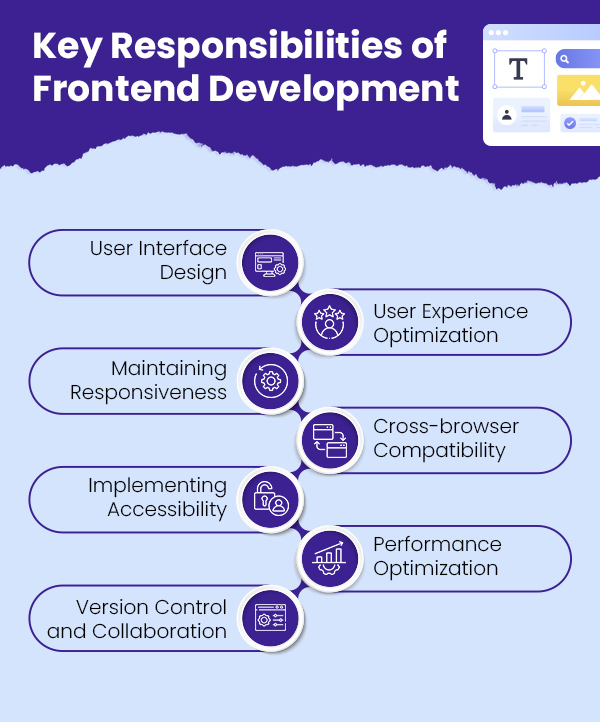
➔ User Interface (UI) Design: Creating visually appealing and user-friendly interfaces that align with the design specifications and brand guidelines. This involves using tools like HTML, CSS, and design frameworks to build the visual aspects of a website or application.
➔ User Experience (UX) Optimization: Assuring the website or application is intuitive and provides a seamless experience for users. This includes optimizing navigation, layout, and overall usability to enhance user satisfaction.
➔ Maintaining Responsiveness: It needs to confirm that the application functions properly on various devices and screen sizes. Responsive design approaches, and frameworks such as Bootstrap and media queries in CSS are used to change layouts and content dynamically.
➔ Cross-browser Compatibility: This maintains and ensures the website or application functions correctly across different web browsers (e.g., Chrome, Firefox, Safari, Edge). This requires testing and resolving issues arising from browser behavior and rendering variations.
➔ Implementing Accessibility: Ensure the online application is accessible to all users, including those with disabilities. This entails adhering to web accessibility standards and criteria, such as WCAG (Web Content Accessibility Criteria), to provide features like keyboard navigation and screen reader assistance.
➔ Performance Optimization: Increasing the web application’s speed and efficiency through asset optimization, load time reduction, and overall performance improvement. Techniques include CSS and JavaScript minification, image optimization, and browser caching.
➔ Version Control and Collaboration: Using version control systems like Git to manage code changes and collaborate effectively with other developers. This involves tracking changes, merging code, and maintaining a clean and organized codebase to facilitate teamwork and continuous integration.
Understanding and executing these responsibilities ensures the developing of high-quality, user-friendly, and efficient web applications.
Also Read: Which Functions Are The Important On A Website?
➢ Challenges and Considerations in Frontend Development
Let’s find out the challenges & considerations that Frontend developers face while working on projects with an infographic below:
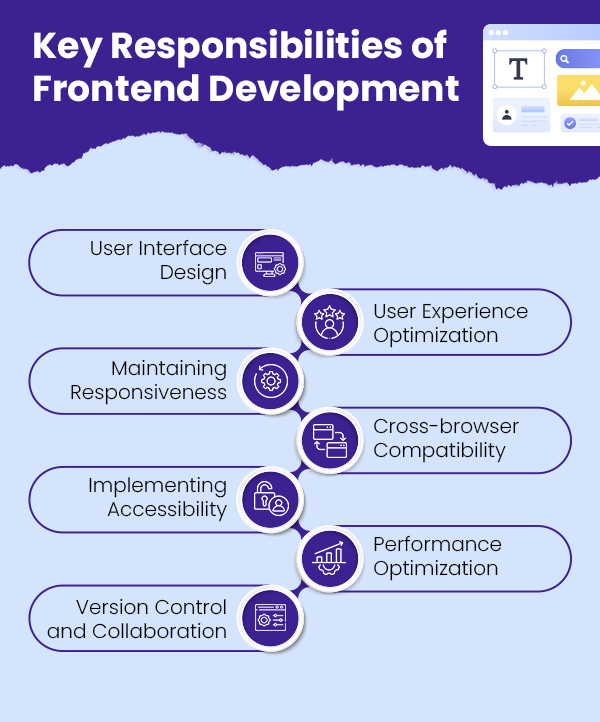
- Rapid Technological Changes: Keeping up with new frameworks and tools in fast-evolving web technologies and features.
- Cross-browser Compatibility: Ensuring consistent functionality across different browsers.
- Performance Optimization: Enhancing load times and efficiency through asset optimization and caching.
- Responsive Design: Creating layouts that work well on all device sizes.
- UX and UI Design: Balancing aesthetics with functionality for a user-friendly experience.
- Accessibility: Making web applications usable for all, including those with disabilities.
- Security: Protecting against vulnerabilities like XSS and CSRF.
- Version Control and Collaboration: Managing code changes and collaboration using systems like Git.
- Debugging and Testing: Identifying and fixing bugs through comprehensive testing.
- Maintaining Consistency: Adhering to style guides and coding standards across the project.
Also Read: WordPress Vs PHP Websites – Difference To Know
Backend Development
Backend development refers to the server-side part of web development. It involves creating and managing the technology that powers the server, database, and application logic, ensuring everything runs smoothly behind the scenes.
Backend development encompasses server management, database management, and API development to enable communication between the frontend and backend. It involves implementing core application logic, ensuring security through authentication and data protection, and optimizing performance and scalability.
It also entails integrating third-party services, doing comprehensive testing and debugging, and utilizing version control systems like Git to manage code changes and cooperate with other engineers.
Also Read: What Is A Headless Commerce Platform – A Complete Guide
Technologies and Tools Used in Backend Development
Server-side Languages:
➔ Python: A versatile and widely-used language known for its readability and extensive libraries.
➔ Ruby: Known for its simplicity and productivity, it is often used with the Ruby on Rails framework.
➔ Java: A robust, object-oriented language commonly used in large-scale enterprise applications.
➔ PHP: A server-side scripting language developed for web development and widely used for building dynamic websites.
Also Read: What Makes A Good Website Checklist? A Complete Guide
Databases:
➔ MySQL: It’s a very popular open-source relational database management system known for its reliability and ease-of-use, globally. One of its convenient features is the ability to easily perform a MySQL export to CSV, simplifying data exports.
➔ MongoDB: This is a NoSQL database which is known for its flexibility and scalability, ideal for handling large volumes of unstructured data.
➔ PostgreSQL: An advanced open-source relational database known for its robustness, extensibility, and standards compliance.
Frameworks:
➔ Node.js: A JavaScript framework built on Chrome’s V8 engine, allowing for server-side scripting using JavaScript and enabling the development of scalable network applications.
➔ Django: This is a high-level Python framework that encourages rapid development and a neat, sensible design.
➔ Flask: A lightweight Python web framework that supplies the essential tools and libraries for building web applications.
➔ Ruby on Rails: This framework is written in Ruby, emphasizing convention over configuration and rapid development.
Also Read: How You Can Find Bugs In Websites Manually?
Key Responsibilities of Backend Development
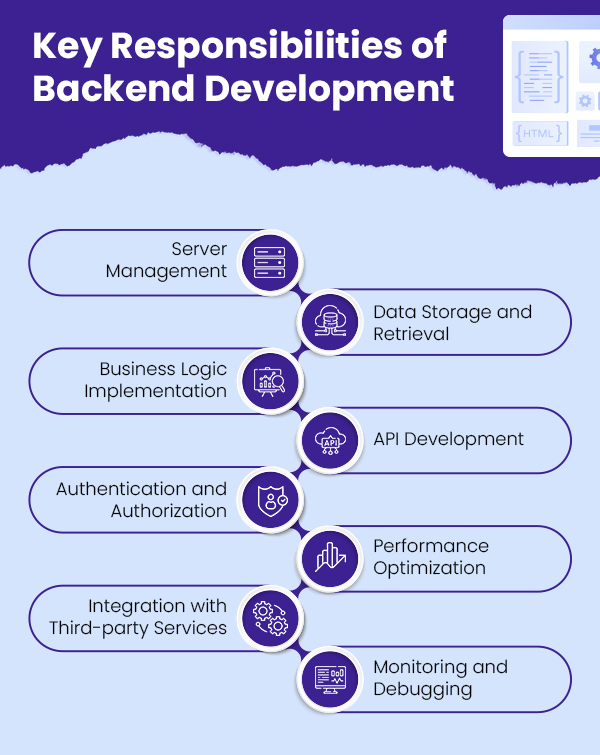
➔ Server Management: The backend is responsible for configuring and maintaining servers to ensure the reliable hosting of web applications.
➔ Data Storage and Retrieval: Designing and managing databases to efficiently store and retrieve data as needed by the application.
➔ Business Logic Implementation: Developing the core functionality of the application, including algorithms, calculations, and data processing.
➔ API Development: The backend development is responsible for creating and managing application programming interfaces (APIs) to enable communication between the frontend and backend components.
➔ Authentication and Authorization: Implementing mechanisms to verify user identities and control access to resources within the application.
➔ Performance Optimization: Majorly responsible for enhancing the speed and efficiency of the application by optimizing code, database queries, and server configurations.
➔ Integration with Third-party Services: Connecting with external services and APIs to leverage additional functionalities or resources.
➔ Monitoring and Debugging: It helps us continuously monitor the application’s performance and reliability, identifying and fixing issues through debugging and troubleshooting.
Also Read: Will AI Replace Web Developers – Know The Truth
Challenges and Considerations in Backend Development
Let’s find out the challenges & considerations that backend developers face while working on projects with an infographic below:
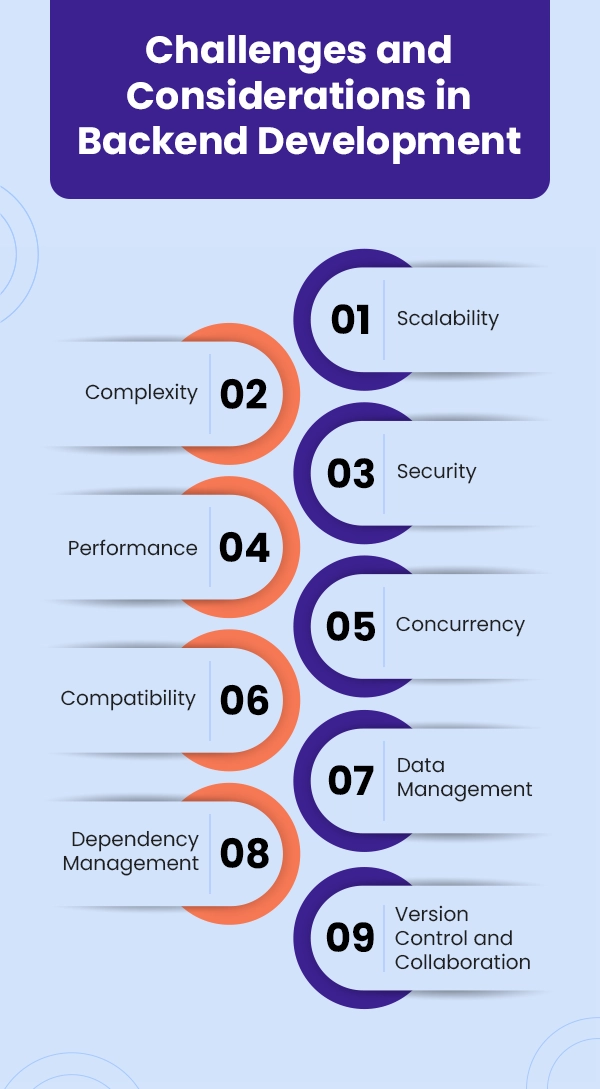
➔ Scalability: Building backend systems that can handle increased load and traffic as the application grows in popularity and usage.
➔ Complexity: It can be challenging to deal with the intricacies of backend architecture, including database design, server configurations, and application logic.
➔ Security: Protecting the backend against threats like unauthorized access, data breaches, and injection attacks.
➔ Performance: Optimizing backend systems to ensure fast response times and efficient resource usage, even under heavy loads.
➔ Concurrency: Managing multiple requests and operations simultaneously while maintaining data integrity and consistency.
➔ Compatibility: Ensuring compatibility with different operating systems, databases, and third-party services to support diverse environments.
➔ Data Management: Handling data storage, retrieval, and manipulation efficiently to meet application requirements and user expectations.
➔ Dependency Management: Managing dependencies on external libraries, frameworks, and services to ensure smooth operation and minimize potential risks.
➔ Version Control and Collaboration: Implementing effective version control strategies and collaborating with other developers to manage code changes and updates.
Also Read: How Can You Make A Website Look More Professional?
Frontend Development vs Backend Development
Let’s find out the difference between frontend & backend development with an infographic below:
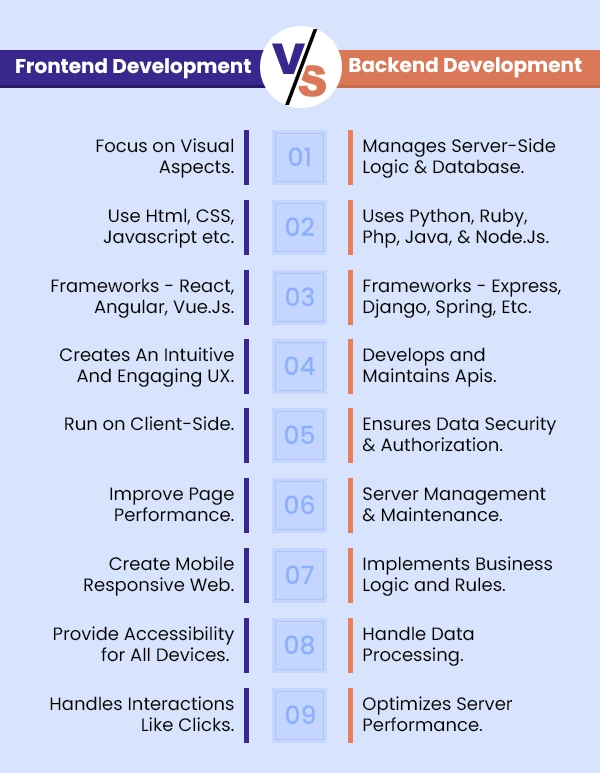
Also Read: Best YouTube Channels For Learning Web Development
Final Thoughts
Comprehensive web development requires understanding the distinctions between frontend and backend development. While the back end manages server-side logic, data storage, and application functionality, the front end concentrates on the user interface and experience, which includes visual components and interactivity.
Gaining expertise in these fields promotes innovation and provides a comprehensive understanding in web development, improving teamwork, problem-solving, user experience, and job prospects.


